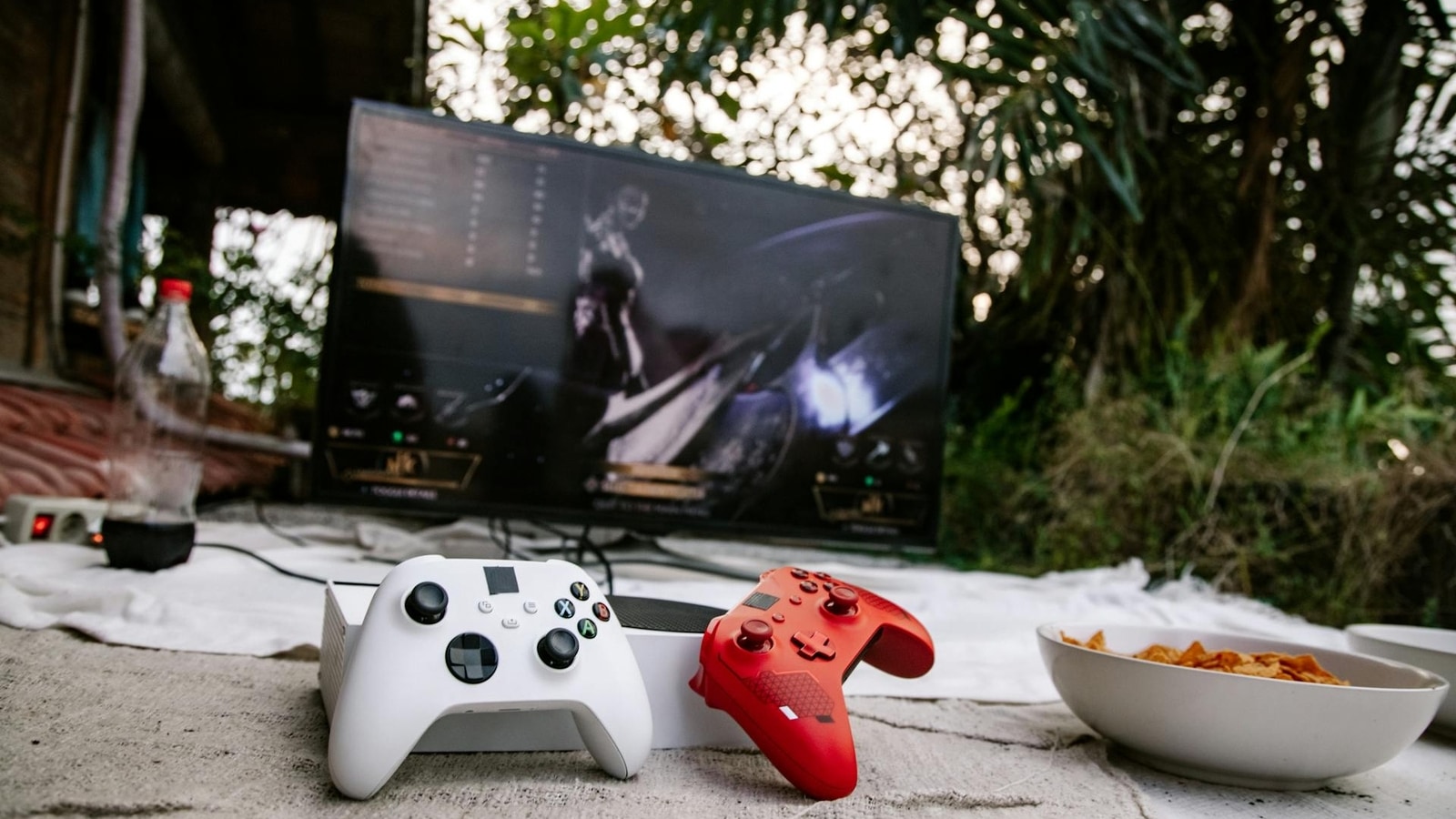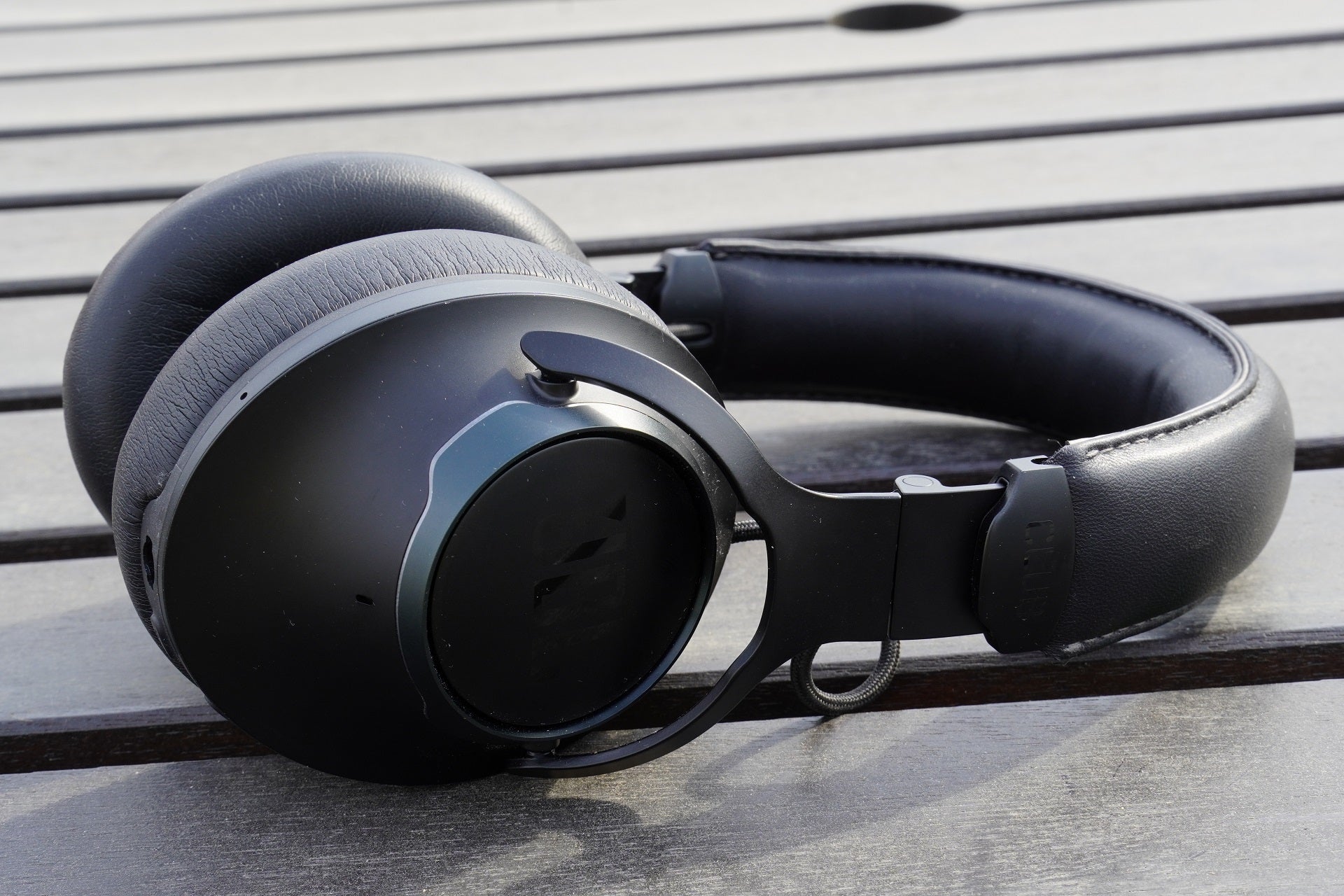Verdict
JBL’s Club One are well-built, look great and sound good too. They fall short of the top tier headphones due to tough competition, and a noise-cancelling performance that’s not the strongest.
Pros
- Clean and natural-sounding presentation
- Great looks
- Strong build quality
Cons
- Not the strongest noise-cancelling
- Rather polite sense of dynamism
Availability
- UKRRP: £299
- USARRP: $350
- EuropeRRP: €349
- CanadaRRP: CA$469
- AustraliaRRP: AU$500
Introduction
The Club One is JBL’s attempt at gate-crashing the premium noise-cancelling party currently being enjoyed by the likes of Bose and Sony.
It’s a task that’s no easy feat, but JBL appears confident it has what it takes to make a splash. The overall performance of the Club One headphones indicates its confidence is not misplaced, either.
Design
- Hefty looking pair of headphones
- Tight clamping force
- Physical buttons over touch controls
The JBL Club One are big for a pair of wireless over-ears. But they wear their heft well and the design has a slight retro feel to it.
They’re gifted with an elegant design, the black finish along with the gentle curves grants them a sleek look despite the size. The silver accents on the ear cups are a nice touch, with the metal hinges emphasising the premium feel while suggesting a level of durability.
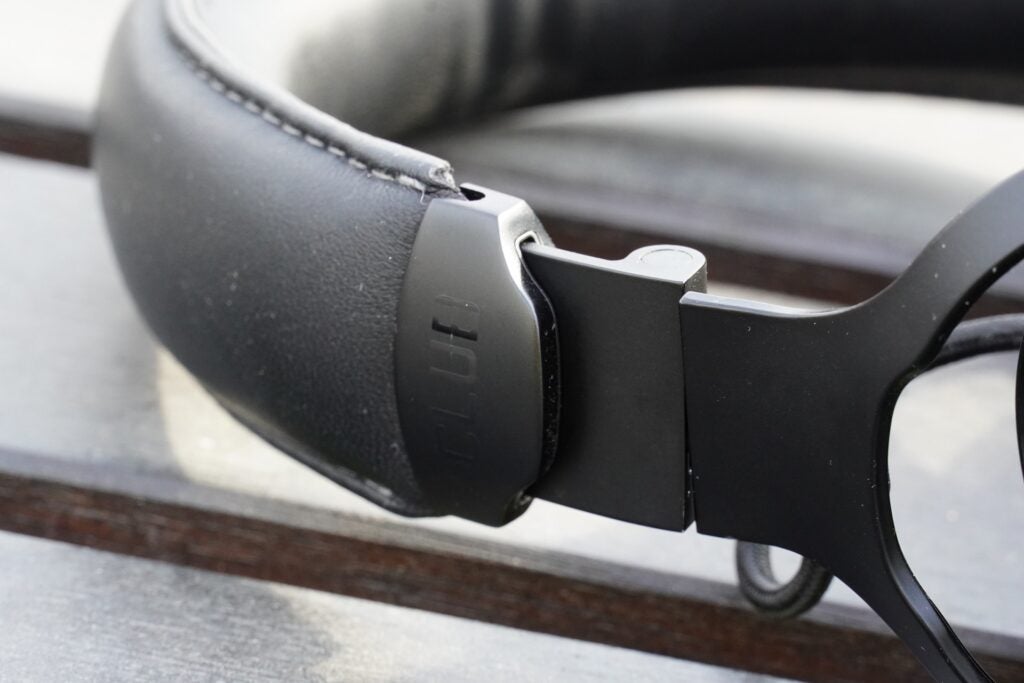
At 378g they’re not as light as the Bose NC 700 Headphones (250g), and they’re 70g heavier than even the Px7 S2. I’ve not had many issues in terms of comfort – the amount of padding on both the earpads and the plush leather headband makes sure of that – but if you wear glasses along with a face-mask, I’ve found the pressure can distract over long periods.
Clamping force is tight, though not to the point where the headphones become unbearable. You’ll certainly notice them, and if you prefer a lighter touch then perhaps these headphones aren’t for you.
Nevertheless, the construction is of such a quality that they don’t feel as if they will ever break. They do come in a very compact carry case, and I defy anyone to put the headphones back as they originally were and zip it up without encountering some difficulty.
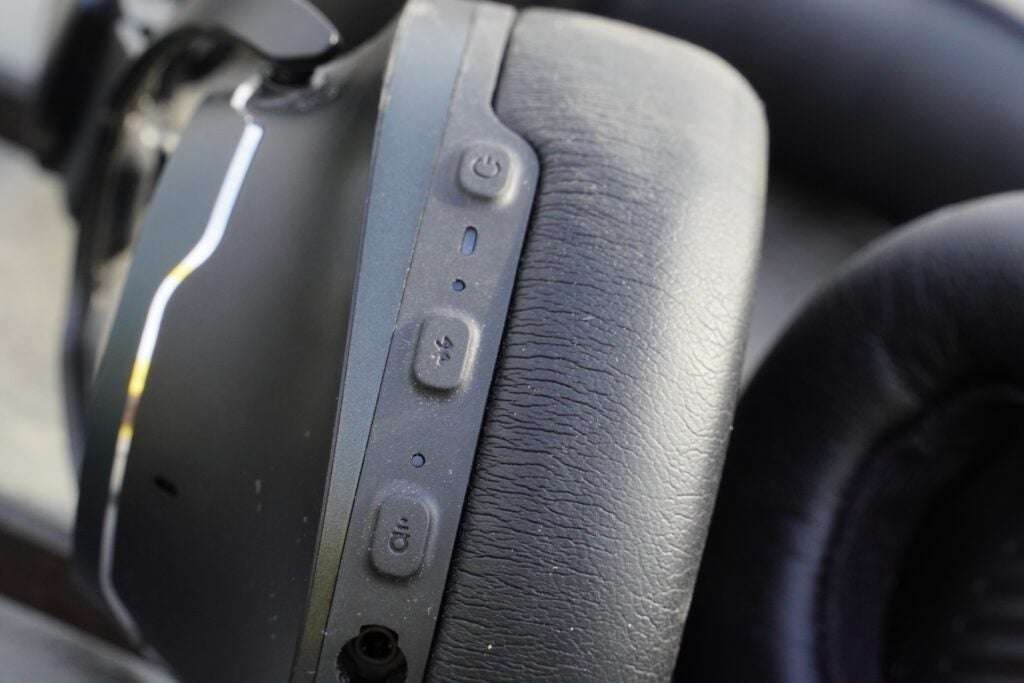
Those who aren’t in favour of touch controls will relish the feedback of physical buttons divided across the two earcups. On the left are the power, Bluetooth pairing and the Ambient Aware buttons, while on the right there are the playback/volume controls, along with a USB-C connection.
The buttons are well spaced out, responsive and where playback is concerned, you can tell which-is-which thanks to raised buttons. There’s also enough space for a dual aux input so you can plug a cable in on either side.
Another rather neat design touch is that the driver housing inside the earpad is covered by a clear piece of plastic, so you can see the custom 40mm orange graphene drivers. Is it needed? No, but does it add to their appeal? I’d say so.
Features
- 23 hours of battery life
- Hi-Res Audio support (via wired connection)
- Adaptive Noise Cancellation
- EQ options in app
The JBL Club One comes with all the hallmarks you’d expect from a premium pair of wireless headphones. They have adaptive noise cancellation, ambient awareness, voice assistance, Bluetooth 5.0 connectivity, and Hi-Res Audio support but only through a wired connection.
Voice assistance is a choice of Google Assistant or Amazon Alexa and is activated by nudging the JBL logo on the left earcup. It’s quite a simple and casual way of interfacing with the headphones which I like.
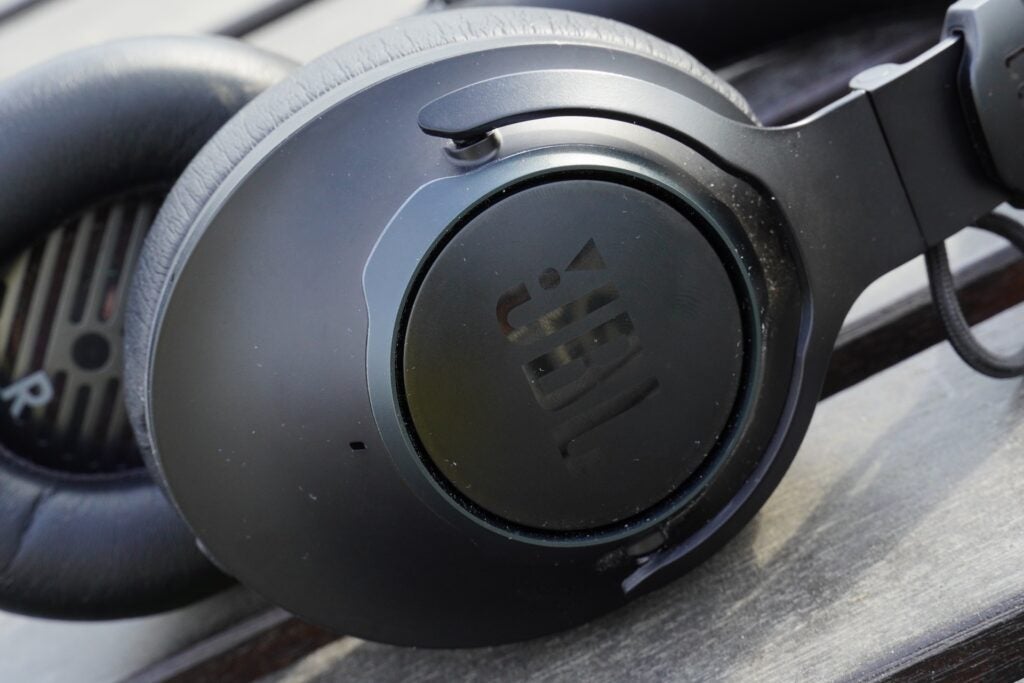
23 hours of battery life is fine – Sony and B&W push it to 30 hours, Sennheiser has taken it to 60 – but 23 is enough for several days of regular use and better than the AirPods Max. Switch ANC off and battery life can be stretched to 45 hours; mix passive use (a cable) with ANC, and you’ll get 25 hours of playback, while filling up the tank to full takes less than two hours.
Its noise-cancelling isn’t the strongest on the market, using the adaptive form that constantly adjusts to its environment and is smart enough to even tell whether you’re wearing glasses, or your head is moving or if hair is in the way. The Club One are good at reducing environmental sounds, with cars and buses reduced to whooshing by, but it’s not the isolating cocoon the Sony or Technics have conjured up with their headphones. At least using ANC doesn’t affect the sound, which can’t always be taken for granted.
There’s the My JBL Headphones app (iOS, Android) – which offers a degree of customisation. It’s simple, visually orientated, and easy to use. Jump into the settings and you can assign which voice assistant you want or whether to enable auto-off. Back on the home screen are the Smart Ambient and Noise Cancelling options, plus a battery life indicator.
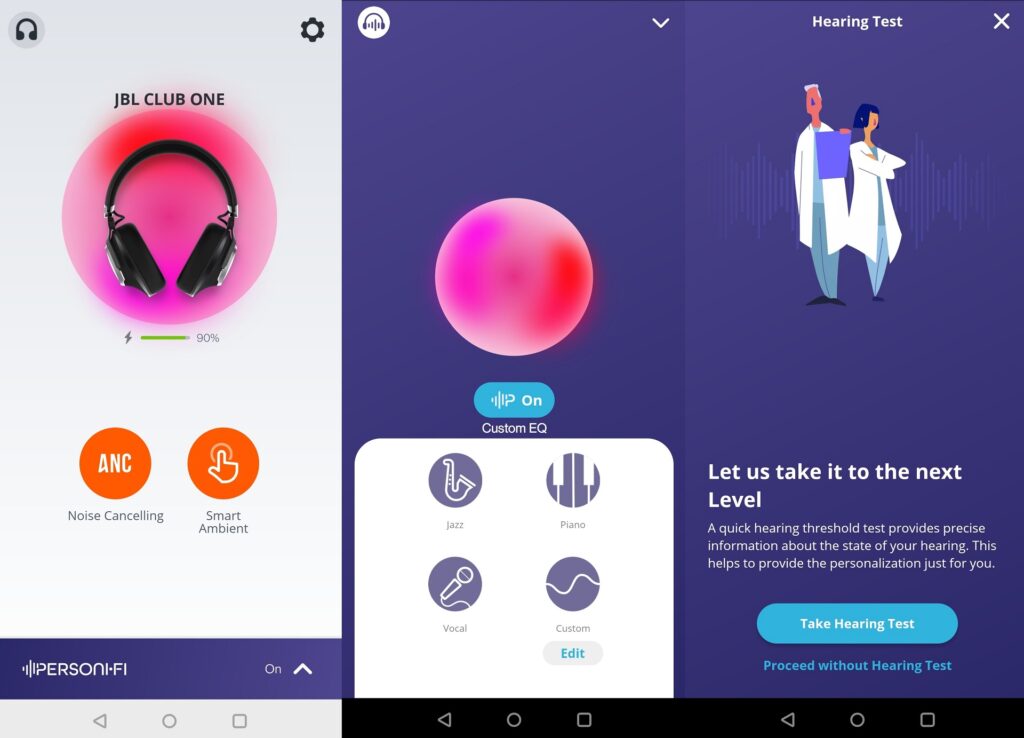
The app has swapped out the STAGE+ EQ settings for Person-Fi, which personalises the sound of the headphones to your listening ability. It takes you through a process where a series of tones are played and the volume is adjusted to the level where you can barely hear it, creating a custom EQ setting for you. It plays like a game and takes around ten minutes. For me the EQ focused more on vocals, made music sound smoother and reduced the size of the soundstage, I actually preferred listening to music with it off.
The five signature sounds of famous DJs from around the world have been summarily dismissed (they weren’t particularly good anyway), and there’s the same number of presets (Piano, Jazz, Vocal), along with the opportunity to create a custom equaliser band from 32Hz to 16kHz.
Press the Smart Ambient button and there are two options presented: Ambient Aware mode or TalkThru. The former filters more sounds through for more awareness – it’s effective but I could be clearer. TalkThru reduces the volume of audio, so the wearer can have a conversation with the headphones on.
Sound Quality
- Balanced sound
- Needs volume pushed up for full expression
What separates middling, good and great headphones is sound quality and the Club One falls into the very-good but not excellent category.
JBL has made much about its Legendary Pro Sound inspired by professional musicians, and there’s definitely a quality to the sound that’s clear and balanced in its approach to music.
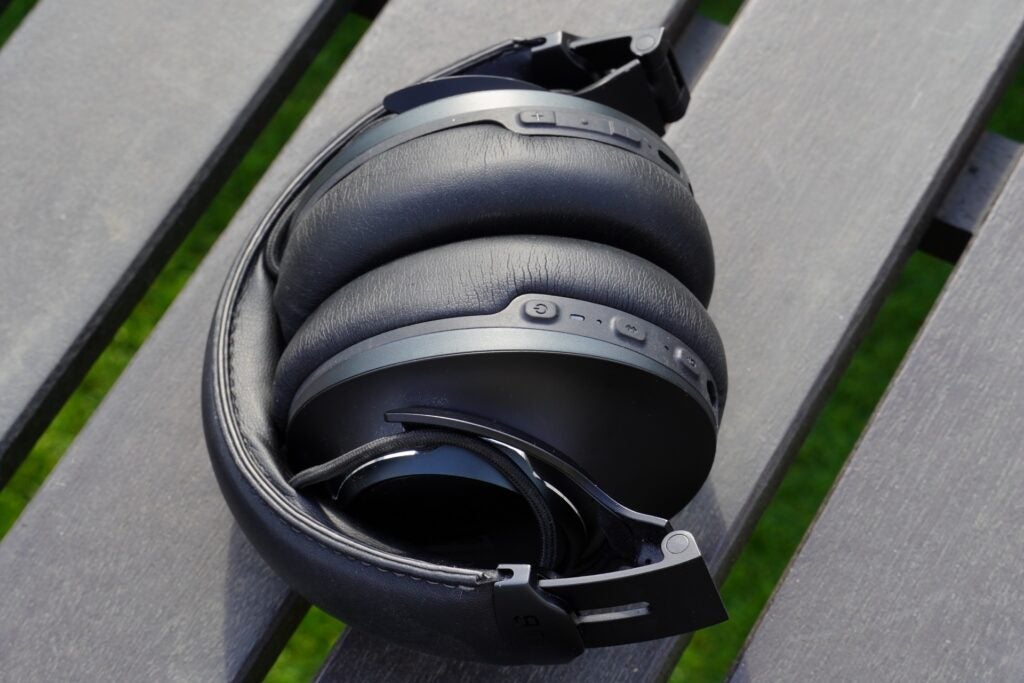
Treble is clear and detailed but not as bright or as articulate with GoGo Penguin’s Raven as the Sony WH-1000XM4. The JBL don’t have as much weight, explosiveness or power to the low frequencies, treating them in a more reserved manner.
So while the soundstage is described in wide and spacious terms, its sense of dynamism and energy is lacking in comparison to the XM4 at comparable volumes. The volume needs to be pushed up to get the most from these headphones.
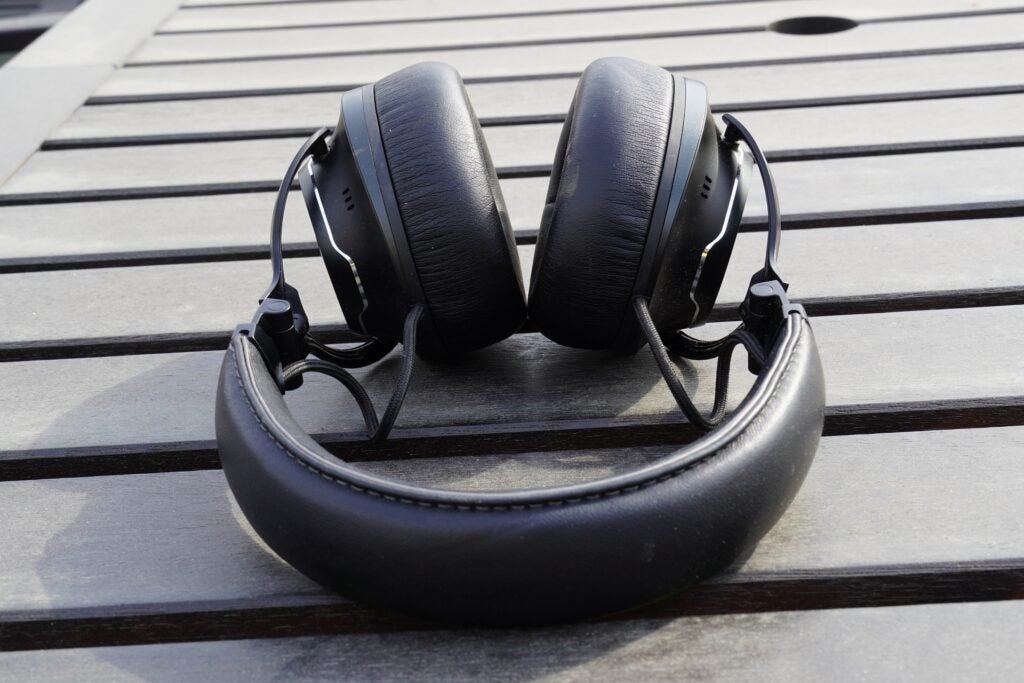
A Tidal Master stream of Alexandre Desplat’s The Shape of Water, and each instrument exists in its own pocket of space, tied together with an enjoyable sense of timing. There’s good clarity and detail to vocals in Korn’s Blind or Justin Timberlake’s Filthy.
But the Sony’s sense of energy; it’s rich, textured sound and spacious soundstage make for a much more entertaining listen. Its sense of scale and dynamism (the Club One are a bit too polite in this regard), is greater than the JBL is capable of, especially as the Club One sound thinner than our top-rated ANC wireless headphones.
Latest deals
Should you buy it?
You want tonally balanced sound The JBL offers a fine, detailed and balanced sound, that’s fairly neutral in tone.
You want a more dynamic performer The JBL are rather polite when it comes to showcasing dynamics, so it’s not the most invigorating of listens.
Final Thoughts
The JBL Club One sound very good, offering a nuanced, detailed listen but for bass and energy there are better noise cancelling cans. They’ve dropped to under £200, and at that price they’re still worthy of consideration and that price drop does suggest a new pair is on the way. You may want to hold off and see if JBL has anything in the pipeline.
How we test
We test every headphone we review thoroughly over an extended period of time. We use industry standard tests to compare features properly. We’ll always tell you what we find. We never, ever, accept money to review a product.
Find out more about how we test in our ethics policy.
Jargon buster
Bluetooth
Bluetooth – named after 10th-century Danish king Harald Bluetooth who united Denmark’s tribes into a single kingdom – is a method of wireless transmission that allows for the exchange of data between devices over short distances.
ANC
ANC (Active Noise Cancellation) uses an array of microphones in a headphone to detect the frequency of the sound coming at the listener, with the ANC chip creating an inverse wave (i.e. opposing sound) to suppress any unwanted external noises.
Verdict
JBL’s Club One are well-built, look great and sound good too. They fall short of the top tier headphones due to tough competition, and a noise-cancelling performance that’s not the strongest.
Pros
- Clean and natural-sounding presentation
- Great looks
- Strong build quality
Cons
- Not the strongest noise-cancelling
- Rather polite sense of dynamism
Availability
- UKRRP: £299
- USARRP: $350
- EuropeRRP: €349
- CanadaRRP: CA$469
- AustraliaRRP: AU$500
Introduction
The Club One is JBL’s attempt at gate-crashing the premium noise-cancelling party currently being enjoyed by the likes of Bose and Sony.
It’s a task that’s no easy feat, but JBL appears confident it has what it takes to make a splash. The overall performance of the Club One headphones indicates its confidence is not misplaced, either.
Design
- Hefty looking pair of headphones
- Tight clamping force
- Physical buttons over touch controls
The JBL Club One are big for a pair of wireless over-ears. But they wear their heft well and the design has a slight retro feel to it.
They’re gifted with an elegant design, the black finish along with the gentle curves grants them a sleek look despite the size. The silver accents on the ear cups are a nice touch, with the metal hinges emphasising the premium feel while suggesting a level of durability.

At 378g they’re not as light as the Bose NC 700 Headphones (250g), and they’re 70g heavier than even the Px7 S2. I’ve not had many issues in terms of comfort – the amount of padding on both the earpads and the plush leather headband makes sure of that – but if you wear glasses along with a face-mask, I’ve found the pressure can distract over long periods.
Clamping force is tight, though not to the point where the headphones become unbearable. You’ll certainly notice them, and if you prefer a lighter touch then perhaps these headphones aren’t for you.
Nevertheless, the construction is of such a quality that they don’t feel as if they will ever break. They do come in a very compact carry case, and I defy anyone to put the headphones back as they originally were and zip it up without encountering some difficulty.

Those who aren’t in favour of touch controls will relish the feedback of physical buttons divided across the two earcups. On the left are the power, Bluetooth pairing and the Ambient Aware buttons, while on the right there are the playback/volume controls, along with a USB-C connection.
The buttons are well spaced out, responsive and where playback is concerned, you can tell which-is-which thanks to raised buttons. There’s also enough space for a dual aux input so you can plug a cable in on either side.
Another rather neat design touch is that the driver housing inside the earpad is covered by a clear piece of plastic, so you can see the custom 40mm orange graphene drivers. Is it needed? No, but does it add to their appeal? I’d say so.
Features
- 23 hours of battery life
- Hi-Res Audio support (via wired connection)
- Adaptive Noise Cancellation
- EQ options in app
The JBL Club One comes with all the hallmarks you’d expect from a premium pair of wireless headphones. They have adaptive noise cancellation, ambient awareness, voice assistance, Bluetooth 5.0 connectivity, and Hi-Res Audio support but only through a wired connection.
Voice assistance is a choice of Google Assistant or Amazon Alexa and is activated by nudging the JBL logo on the left earcup. It’s quite a simple and casual way of interfacing with the headphones which I like.

23 hours of battery life is fine – Sony and B&W push it to 30 hours, Sennheiser has taken it to 60 – but 23 is enough for several days of regular use and better than the AirPods Max. Switch ANC off and battery life can be stretched to 45 hours; mix passive use (a cable) with ANC, and you’ll get 25 hours of playback, while filling up the tank to full takes less than two hours.
Its noise-cancelling isn’t the strongest on the market, using the adaptive form that constantly adjusts to its environment and is smart enough to even tell whether you’re wearing glasses, or your head is moving or if hair is in the way. The Club One are good at reducing environmental sounds, with cars and buses reduced to whooshing by, but it’s not the isolating cocoon the Sony or Technics have conjured up with their headphones. At least using ANC doesn’t affect the sound, which can’t always be taken for granted.
There’s the My JBL Headphones app (iOS, Android) – which offers a degree of customisation. It’s simple, visually orientated, and easy to use. Jump into the settings and you can assign which voice assistant you want or whether to enable auto-off. Back on the home screen are the Smart Ambient and Noise Cancelling options, plus a battery life indicator.

The app has swapped out the STAGE+ EQ settings for Person-Fi, which personalises the sound of the headphones to your listening ability. It takes you through a process where a series of tones are played and the volume is adjusted to the level where you can barely hear it, creating a custom EQ setting for you. It plays like a game and takes around ten minutes. For me the EQ focused more on vocals, made music sound smoother and reduced the size of the soundstage, I actually preferred listening to music with it off.
The five signature sounds of famous DJs from around the world have been summarily dismissed (they weren’t particularly good anyway), and there’s the same number of presets (Piano, Jazz, Vocal), along with the opportunity to create a custom equaliser band from 32Hz to 16kHz.
Press the Smart Ambient button and there are two options presented: Ambient Aware mode or TalkThru. The former filters more sounds through for more awareness – it’s effective but I could be clearer. TalkThru reduces the volume of audio, so the wearer can have a conversation with the headphones on.
Sound Quality
- Balanced sound
- Needs volume pushed up for full expression
What separates middling, good and great headphones is sound quality and the Club One falls into the very-good but not excellent category.
JBL has made much about its Legendary Pro Sound inspired by professional musicians, and there’s definitely a quality to the sound that’s clear and balanced in its approach to music.

Treble is clear and detailed but not as bright or as articulate with GoGo Penguin’s Raven as the Sony WH-1000XM4. The JBL don’t have as much weight, explosiveness or power to the low frequencies, treating them in a more reserved manner.
So while the soundstage is described in wide and spacious terms, its sense of dynamism and energy is lacking in comparison to the XM4 at comparable volumes. The volume needs to be pushed up to get the most from these headphones.

A Tidal Master stream of Alexandre Desplat’s The Shape of Water, and each instrument exists in its own pocket of space, tied together with an enjoyable sense of timing. There’s good clarity and detail to vocals in Korn’s Blind or Justin Timberlake’s Filthy.
But the Sony’s sense of energy; it’s rich, textured sound and spacious soundstage make for a much more entertaining listen. Its sense of scale and dynamism (the Club One are a bit too polite in this regard), is greater than the JBL is capable of, especially as the Club One sound thinner than our top-rated ANC wireless headphones.
Latest deals
Should you buy it?
You want tonally balanced sound The JBL offers a fine, detailed and balanced sound, that’s fairly neutral in tone.
You want a more dynamic performer The JBL are rather polite when it comes to showcasing dynamics, so it’s not the most invigorating of listens.
Final Thoughts
The JBL Club One sound very good, offering a nuanced, detailed listen but for bass and energy there are better noise cancelling cans. They’ve dropped to under £200, and at that price they’re still worthy of consideration and that price drop does suggest a new pair is on the way. You may want to hold off and see if JBL has anything in the pipeline.
How we test
We test every headphone we review thoroughly over an extended period of time. We use industry standard tests to compare features properly. We’ll always tell you what we find. We never, ever, accept money to review a product.
Find out more about how we test in our ethics policy.
Jargon buster
Bluetooth
Bluetooth – named after 10th-century Danish king Harald Bluetooth who united Denmark’s tribes into a single kingdom – is a method of wireless transmission that allows for the exchange of data between devices over short distances.
ANC
ANC (Active Noise Cancellation) uses an array of microphones in a headphone to detect the frequency of the sound coming at the listener, with the ANC chip creating an inverse wave (i.e. opposing sound) to suppress any unwanted external noises.








